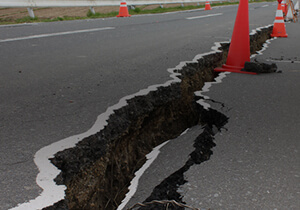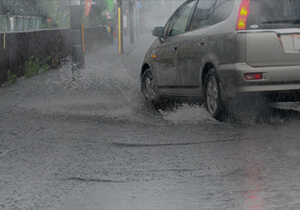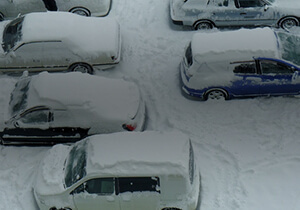What to be careful of on snow-covered and icy roads

To prevent troubles caused by heavy snowfall
Driving on snow-covered roads
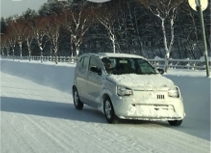
- It is extremely dangerous to drive on snowy roads with regular tires, so make sure to use snow tires or chains.
- Due to the risk of skidding, avoid sudden lane changes and abrupt braking.
- Maintain a generous following distance from the vehicle in front of you.
- When starting, gently press the accelerator and begin moving slowly.
- Snow accumulated on the roof can cause an avalanche onto the front windshield during braking, leading to impaired visibility. Therefore, clear the snow off the roof before driving.
Normal tires can run on snowy roads but cannot stop [JAF User Test]
Precautions for Driving on Ice-covered Roads

Driving on an ice-covered road requires extra caution, as it is more slippery than snowy roads.
- Be particularly vigilant when the snow that accumulated during the day melts or when temperatures drop significantly after rain, creating a phenomenon known as 'black ice,' where the road surface appears wet and black but is actually frozen. In such conditions, known as 'Black Ice' .
- In the case of 'Black Ice,' cautious driving, anticipating slippery conditions, is essential. Abrupt actions with 'sudden' elements, such as rapid acceleration, sudden stops, and sharp turns, are strictly prohibited.
- The areas most dangerous are on bridges, overpasses with good airflow, and near tunnel entrances and exits.
- Navigate by following the arrows and reflective poles along the road edge, indicating the boundary with the roadside.
If you get stuck on a snow-covered road
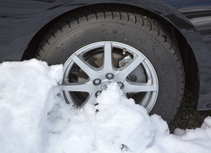
- If your tires skid or get stuck in fresh snow, slowly move the car back and forth tread down the snow around the tires.
- If you find a gravel box at the roadside, scatter the gravel around the driving wheel.
When you get stuck in heavy snowfall and cannot move
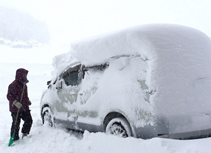
- If you’re in a whiteout such as a snowstorm, turn on your hazard lamps and stop at a safe place.
- If the exhaust port is plugged with snow, you are at risk of carbon monoxide poisoning.
- While waiting for rescue to arrive, clear at least enough snow for the exhaust to vent.
Things you should know about snow-covered roads
In addition to using your eyes to maneuver on snowy roads, it is especially important to make predictions. Practice simulations of driving on snowy roads and learn the tips of predicting danger.
What to know about snow-covered roads
What to prepare before driving on snow-covered roads
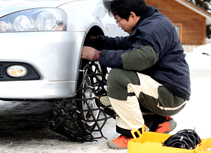
- Regular washer fluid can freeze. Replace it with washer fluid for freezing weather.
- Be sure to carry tire chains and a jack, even you are wearing studless tires.
- It's a good idea to have a booster cable in the wintertime in case of unforeseen circumstances.
- Blankets can help to keep you warm inside the car in an emergency.
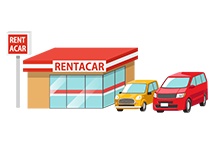
Instead of changing tires, you also have the option of renting a car!
In areas where it doesn't snow very often, there's always the option of renting a car when the need to drive on snow-covered roads arises.
Rental cars are often fitted with studless tires for the winter season so you can drive right onto a snow-covered road as soon as you rent the car. Also, washer fluid for freezing weather is always replenished.
If a problem does happen to occur, as long as you are a JAF member, you can rest assured that you will receive the same roadside assistance in your rental car as you would in your own car.
Features:
| Safety | Affordability | Convenience | |
|---|---|---|---|
| Studless tiresStudless tires |
With studless tires installed on all four wheels, you can expect stable gripping performance. The technical innovations that go into making studless tires recently is remarkable. This is what gives the new products high gripping performance. | A set of four studless tires and wheels will last you two seasons depending on mileage and other factors, so it might be worth spending the extra money if you drive on snow-covered roads often. | Once you change to studless, you can enjoy the convenience of being able to drive on snow-covered roads at any time. Make sure to have a place to store your regular tires in the meantime, and don't forget where you put them. |
| Tire ChainsTire Chains |
The two tires without chains are exposed summer tires. This might make it difficult to drive in some situations such as downhill curves, but you can rely on their hill climbing performance. | Chains are relatively less expensive than studless tires. Depending on the size you need, they might be difficult to obtain, so check with your dealer or other retailers well before you need them. | Except on snow-covered roads, you cannot drive at high speeds wearing chains. Be sure to install them on location. This means that you will need to install them outside in the cold that you are not accustomed to. |
| Rental CarsRental Cars |
Most rental cars are fitted with studless tires in the wintertime, but be sure to check just in case, when making your reservation. Choose a vehicle with ESC (electronic stability control to prevent skidding) to ensure an even higher level of safety. | Renting a car can cost anywhere between a few thousand yen and tens of thousands. It may seem expensive but various discounts are available these days. Look for a car rental service that offers discounts to JAF members. | Washer fluid will always be replenished properly. Because it is not your own car that you are accustomed to, you might experience increased fatigue and stress while driving. Make your reservation early, especially during busy periods like the year-end and New Year holidays. |
Check points before driving on snow-covered roads
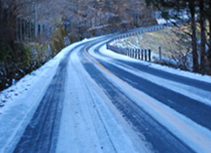
1. Design your route around main throughways.
Design your driving route to follow main roads as much as you can. Often, even if a road looks like a two-lane street on the map, the snow can turn it into a single lane. Unexpected deep snow on a narrow street can also cause you to get stuck.
Overreliance on your car navigation system can also be dangerous. Navigation systems cannot tell you the road conditions. There could be a steep hill that is difficult to climb. Don't expect to find your way out of a snow-covered road and try to stick to the main streets.
2. Overestimate your driving time.
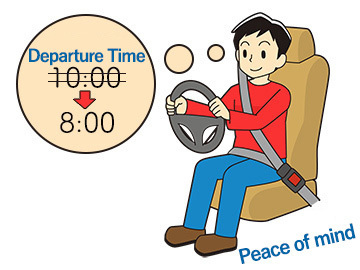
Make a driving schedule with plenty of time to spare. On snow-covered roads, you will need to drive at a lower speed than usual, and depending on snowfall conditions, many other factors such as road closures or detours can slow you down.
3. Gather information from weather forecasts and other sources.
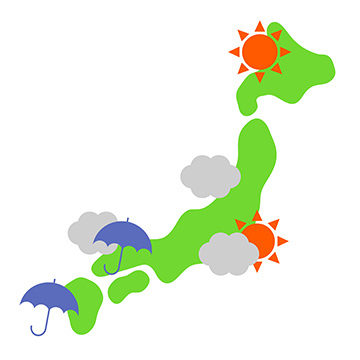
Start gathering information about the snow conditions at your destination several days before you leave.
You can also check road conditions on the JARTIC (Japan Road Traffic Information Center) website. On the day of traveling, you can check traffic conditions on live cameras at Service Areas and other locations.
JAF's road service is also available for natural disasters.
JAF's road service also covers accidents or breakdowns caused by natural disasters such as earthquakes, typhoons, and heavy snow, which are typically excluded from coverage under regular car insurance.
